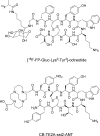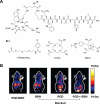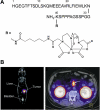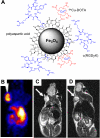Peptides and peptide hormones for molecular imaging and disease diagnosis
- PMID: 20225899
- PMCID: PMC2868934
- DOI: 10.1021/cr900361p
Peptides and peptide hormones for molecular imaging and disease diagnosis
Figures




















Similar articles
-
Phage display in molecular imaging and diagnosis of cancer.Chem Rev. 2010 May 12;110(5):3196-211. doi: 10.1021/cr900317f. Chem Rev. 2010. PMID: 20170129 Free PMC article. Review. No abstract available.
-
Targeting Peptide-Based Probes for Molecular Imaging and Diagnosis.Adv Mater. 2019 Nov;31(45):e1804827. doi: 10.1002/adma.201804827. Epub 2018 Dec 7. Adv Mater. 2019. PMID: 30537222 Review.
-
Protein and peptide probes for molecular imaging.Amino Acids. 2011 Nov;41(5):1009-12. doi: 10.1007/s00726-011-0945-8. Amino Acids. 2011. PMID: 21643775 Free PMC article. No abstract available.
-
Optical and multimodal peptide-based probes for in vivo molecular imaging.Anticancer Agents Med Chem. 2012 Jun;12(5):476-99. doi: 10.2174/187152012800617858. Anticancer Agents Med Chem. 2012. PMID: 22292759 Review.
-
Peptide-based nanoprobes for molecular imaging and disease diagnostics.Chem Soc Rev. 2018 May 21;47(10):3490-3529. doi: 10.1039/c7cs00793k. Chem Soc Rev. 2018. PMID: 29497722 Review.
Cited by
-
Target molecule imaging on tissue specimens by fluorescent metal nanoprobes.J Biomed Opt. 2011 Nov;16(11):116004. doi: 10.1117/1.3644394. J Biomed Opt. 2011. PMID: 22112109 Free PMC article.
-
Enzymatic self-assembly of nanostructures for theranostics.Theranostics. 2012;2(2):139-47. doi: 10.7150/thno.3696. Epub 2012 Feb 2. Theranostics. 2012. PMID: 22375155 Free PMC article.
-
Novel Small Molecule Probes for Metastatic Melanoma.ACS Med Chem Lett. 2016 Dec 9;8(2):179-184. doi: 10.1021/acsmedchemlett.6b00368. eCollection 2017 Feb 9. ACS Med Chem Lett. 2016. PMID: 28197308 Free PMC article.
-
Progress in molecular imaging in endoscopy and endomicroscopy for cancer imaging.J Healthc Eng. 2013;4(1):1-22. doi: 10.1260/2040-2295.4.1.1. J Healthc Eng. 2013. PMID: 23502247 Free PMC article. Review.
-
Anti-Cancer Peptides: Status and Future Prospects.Molecules. 2023 Jan 23;28(3):1148. doi: 10.3390/molecules28031148. Molecules. 2023. PMID: 36770815 Free PMC article. Review.
References
Publication types
MeSH terms
Substances
Grants and funding
LinkOut - more resources
Full Text Sources
Other Literature Sources

